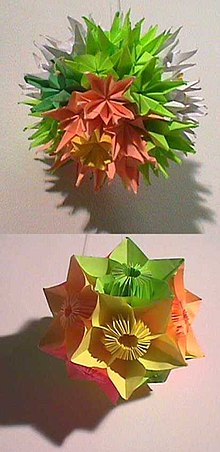
Summary
The Japanese kusudama (薬玉; lit. medicine ball) is a paper model that is usually (although not always) created by sewing multiple identical pyramidal units together using underlying geometric principles of polyhedra to form a spherical shape. Alternately the individual components may be glued together. (e.g. the kusudama in the lower photo is not threaded together) Occasionally, a tassel is attached to the bottom for decoration.[1]

The term kusudama originates from ancient Japanese culture, where they were used for incense and potpourri; possibly originally being actual bunches of flowers or herbs.[2] The word itself is a combination of two Japanese words kusuri ("medicine") and tama ("ball"). They are now typically used as decorations, or as gifts.[3]
The kusudama is important in origami particularly as a precursor to modular origami. It is often confused with modular origami, but is not such because the units are strung or pasted together, instead of folded together as most modular construction are made.[4]
It is, however, still origami, although origami purists frown upon threading or gluing the units together, while others recognize that early traditional Japanese origami often used both cutting (see thousand origami cranes or senbazuru) and pasting, and respect kusudama as an ingenious traditional paper folding craft in the origami world.
Modern origami masters such as Tomoko Fuse have created new kusudama designs that are entirely assembled without cutting, glue, or thread except as a hanger.[5]
Waritama edit
Kusudama can also be used to refer to a type of decoration that is displayed and split open for celebrations. This decoration is more specifically called waritama (割り玉; lit. split ball). Waritama are large, spherical decorations that split in half to release confetti, streamers, balloons, etc. They can be used for a variety of events, including school events, graduation ceremonies, enterprise founding anniversaries, and sports competitions.
An emoji depicting a waritama, called Confetti Ball (🎊), was introduced with the October 2010 release of Unicode 6.0. It is the Emoticons Unicode block: U+1F38A 🎊 CONFETTI BALL.
See also edit
Notes and references edit
- ^ "7 Steps to a Pretty Origami Kusudama Flower". The Spruce Crafts. Retrieved 2018-07-24.
- ^ "Step-By-Step Kusudama Flower Ball". Home Decorating Trends - Homedit. 2016-03-16. Retrieved 2018-07-24.
- ^ "Traditional Japanese kusudama". origami-art.us. Retrieved 2018-07-24.
- ^ "David Lister on Kusudamas". www.britishorigami.info. Retrieved 2018-07-24.
- ^ mulatinho. "origami-galerie". www.origami-galerie.de. Retrieved 2018-07-24.
Further reading edit
- Unit Origami: Multidimensional Transformation Tomoko Fuse, Japan Publications, 1990, ISBN 978-0-87040-852-6
- Floral Origami Globes (New Kusudama) Tomoko Fuse, Japan Publications Trading, 2007, ISBN 978-4-88996-213-0
- Kusudama Origami Tomoko Fuse, Japan Publications, 2002, ISBN 978-4-88996-087-7
- Kusudama: Ball Origami Makoto Yamaguchi, Japan Publications, 1990, ISBN 978-0-87040-863-2
- Origami Ornaments: The Ultimate Kusudama Book Lew Rozelle, St. Martin's Griffin, 2000 ISBN 978-0-312-26369-0
- Origami Flower Ball (Origami Hana Kusudama) (in Japanese) Yoshihide Momotani, Ishizue Publishers, 1994, ISBN 978-4-900747-02-9
- Marvelous Modular Origami Meenakshi Mukerji, A K Peters. 2007, ISBN 978-1-56881-316-5
External links edit
- OrigamiTube.com Learn how to fold kusudama in motion.
- The few good Kusudams with diagrams.
- Video tutorial: How to Fold a Japanese Paper Ball (Kusudama) Archived 2012-10-05 at the Wayback Machine
- kusudama by Atelier Puupuu: diagrams of making kusudama
- kusudama by Lukasheva Ekaterina many models, diagrams and tutorial
- Kusudama by Mikhail Puzakov & Ludmila Puzakova: new models, folding instruction, history, geometry (in Russian)


